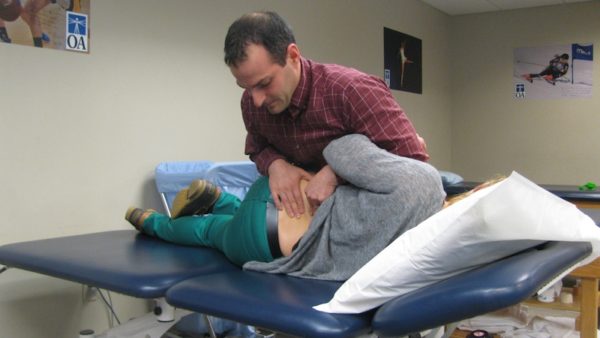How often do you think about your back? Only if it happens to hurt? Even then, do you plow through the pain without stopping to figure out why you have it in the first place?
If you’re lucky, it stops hurting, but chances are you’re still doing whatever it was that caused your pain. And after a while, it’s likely to come back. Sometimes with a vengeance so strong, you can hardly move, and that’s when you finally decide to see your doctor.
Since an estimated ninety percent of people in this country experience back pain at some point in their lives, I thought it might be useful to offer up some preventive medicine. I asked two experts from OA Centers for Orthopaedics for advice on how to take good care of our backs. Dr. Daniel Robbins is an orthopaedic surgeon and spine specialist and Matt Somma is a physical therapist and Director of Rehabilitation Services.
How we hurt our backs
 Dr. Robbins says most back problems are caused by:
Dr. Robbins says most back problems are caused by:
- Staying in the same position for too long
- Bending and twisting
Guilty on both counts. How about you?
I can sit at my computer for hours writing blog posts (I am seriously trying to break that habit). Even people who use standing or sit-stand desks get stuck in the same position. It doesn’t matter what you do throughout your day. If you don’t move, you’re putting your back at risk.
As for bending and twisting, Dr. Robbins says to think of the discs in your spine as similar to steel-belted radial tires. “They’re really good in compression,” he told me, “but not if you take high speed turns, especially as the tires age and become a little under-inflated. They can’t tolerate the high speed turns well and will sometimes tear, rip, or herniate a sidewall.”
Before you do a sudden high-speed twist with your back, stop and imagine a tire tread separation. Humans have about a 40-degree rotational stability. You can rotate 40 degrees from your shoulders to your pelvis. Beyond that, you’re tearing through the collagen in your discs. OUCH!
Learning the language of your spine
Our back/spine talks to us, but what good is that if we don’t listen? When your back hurts even a little bit, what do you think it’s trying to tell you? Probably that you need to stop what you’re doing.
Stop and then try to understand where the pain is coming from. “I tell patients if you don’t understand how you got here, you’re coming back,” said Dr. Robbins. “You need to understand what you did to create the problem in the first place. I hear a lot of patients say it’s been months and months and months, but I can deal with it, I can ignore it, whatever. But that doesn’t address the underlying cause. That’s why early intervention and early education are paramount.”
It’s also important to understand the difference between good and bad pain because, on one hand, you may be worrying unnecessarily or on the other, you’re not concerned enough.
If your muscles are sore, it shows that they’re adapting to movement or exercise. That’s nothing to worry about. If you’ve got pain in a joint or it’s shooting from one area to the next, you should contact your doctor.
In addition to listening to your pain, you should also pay attention to flexibility. It turns out that being flexible in general is not that important. What is important is that you are symmetrically flexible. How can you tell if you are?
“Do a stretch and ask yourself these questions,” said Dr. Robbins. “Is my left side the same as my right and if it isn’t why not? Should it be? Yes. What if, say, your hamstring is tighter on one side than the other? It means you’re taking a shorter stride with the shorter leg, meaning you have to twist your hip around to actually line it up with the other, more flexible leg.”
Whether you have back pain or more tightness on one side than the other, if you don’t want to end up with a chronic or worsening problem, you need to analyze and correct the situation.
Dr. Robbins may be a spine surgeon, but he said he’s never eager to correct a situation by operating on someone. He’d much rather see them early on so he can help them develop healthy spine habits. Even when surgery turns out to be the best option, if the patient doesn’t understand what caused their problem and how to care for and listen to their spine moving forward, history may repeat itself.
Matt agreed that early intervention can help prevent problems down the road. “When I evaluate someone with back pain,” he said, “I look at their back, hips, knees, feet, thoracic spine and neck to see things that may have caused them to move differently and irritate their back or make them compensate somehow for their pain. I can show people what to do and reassure them that moving is a good thing. It can reduce pain.”
Tips on caring for our spines
“Everything stems from the spine,” Matt pointed out to me. “It protects the nervous system and sends signals to arms and legs for sensation, motor control, muscle activity, and feedback. Over time, we tend to develop patterns, slouching patterns, things of that nature that can affect the spine. We never think about them because they don’t bother us until our back starts to hurt.
So … what can we do to take better care of our spine before getting a sore back?
Move. It’s that simple. We do not move enough. If you’re sitting at your computer, stand up walk around your chair and sit down. Even that micromovement is better than staying in the same position. Do it more than once, though.
Maybe you go to the gym several mornings a week. You still need to move throughout the day. “It’s more about changing positions and moving frequently,” Matt explained. “Get up and move around every 20-30 minutes.”
Figure out the best way to remind yourself to move. I use an app on my phone called FocusKeeper. Matt suggested a sticky note — put it where you will see it. “Whatever works for you,” he said. “After a while moving will become a habit, second nature.”
You should also work on strengthening and stretching certain muscles groups. Your butt (gluteus) is at the top of the list. The gluteus muscle is a primary stabilizer of your spine, along with the paraspinal muscles in your lower back and the trapezius muscle in your neck.
Here are a few movements for all three areas that you should do all throughout the day.
- Every time you stand or sit, squeeze your butt muscles on the way up or down. Feels so good.
- As many times as you can throughout the day, pull your belly button in as if you were trying to touch your spine. At the same time, squeeze those butt muscles. You’ll be engaging your core, which is a good thing. Dr. Robbins also suggested doing it when you try to lift something. It will help prevent you from twisting.
- The next movement is something I really need to start doing. Drop your head to your chest. Feel that delicious stretch in the back of your neck. Do it throughout the day. You’ll be grateful and so will your neck.
Movement is usually beneficial even if your back already hurts. “Stay active and keep moving to the best of your ability,” recommended Matt. “Research suggests that bed rest isn’t good. Keep active, keep moving. I might have someone with a post-acute back injury do basic range of motion exercises and continue to try to walk throughout the day. If they can’t or don’t want to do long walks, they could take several ten- minute walk breaks.”
A few thoughts on aging backs
Remember the spring you used to have in your step? Does it sometimes feel more like a thud? Some older people find themselves looking down at their feet when they walk because they’re so fearful of falling. You may think it’s a good tactic that will prevent you from breaking a hip. It isn’t, cautioned Dr. Robbins.
“A broken hip is the ultimate take you out of your life kind of moment,” he said. “Almost every case I’ve seen was because the person was looking downward, looking at their next step. If you think about driving a car, would you look over the hood? And expect not to crash? You need to look outward at the horizon.”
The same is true for walking. If you’re worried, he suggested using a walking stick. He advocates what are called Nordic walking sticks. Using a walking stick will put you in a forward position so that you are standing over the middle of your feet. That’s where you want to be, not looking down at your feet.
“When you get nervous, everything gets very short and truncated,” he explained, “and everything comes at you really fast. You’re not able to make an athletic or supple movement. Instead, it becomes herky-jerky. Another reason to use walking sticks is that you’ll have tactile feedback from your arms. You’ll look outward and feel more confident.”
Oh, my aching back
I’ve given you some basic tips, but when it comes to preventing and/or treating back pain, we are unique individuals. “Back pain is a challenge,” said Matt. “No one should receive the same treatment. You need to figure out what led to your problem, your pain and correct it.”
If your back is hurting you right now and you do not have pain going down your leg, check out this video. That’s Matt on the table.
This next video is for someone who has back and leg symptoms after a disc herniation or if you’ve been diagnosed with sciatic pain.
[/fusion_builder_column][/fusion_builder_row][/fusion_builder_container]




Leave A Comment